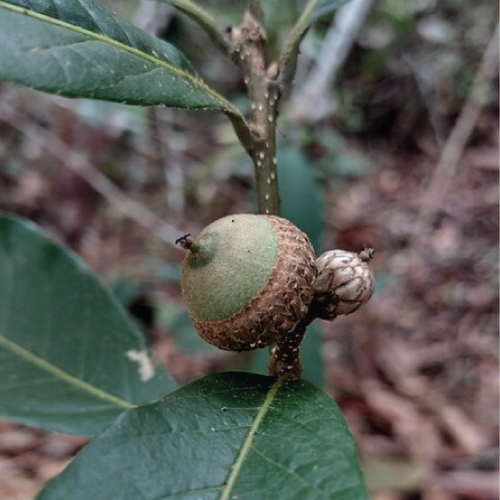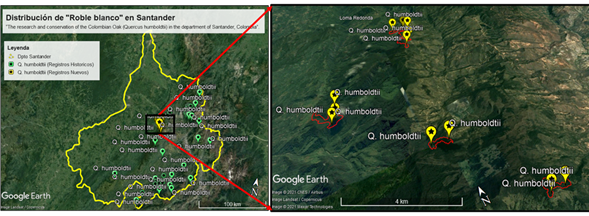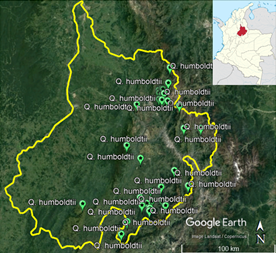The “Colombian White Oak” (Quercus humboldtii), is an arboreal species belonging to the Fagacea family, which is currently on the IUCN red list (2021) in the category of Least Concern (LC), while according to the Red Book of Plants of Colombia this species is in the Vulnerable (VU) category (Cárdenas & Salinas 2006).
The origin of the genus Quercus spp is very old, with fossils dating back to the Lower Cretaceous and which dispersed in America with an approximate diversity of 400 species distributed in different forest ecosystems, from Canada to the Andes of Colombia where only one species could prosper (Aguilar 2006). In accordance with the above, authors such as Van der Hammen 1974 estimate that the Quercus humboldtii (Bonpl 1805) species was established in the Colombian Andes approximately 300,000 years ago, the eastern mountain range being its main area of occupation, where it probably replaced other plant communities and became established with other tree species forming dominant associations that are generally called “Robledales”.
Habitat of the Colombian oak
The Colombian Oak (Quercus humboldtii) is a species that is considered endemic to the mountains of Colombia, however, it is also present in the Panamanian Darién (GBIF 2021). It is distributed in an altitudinal range between 750 to 3.450 meters above sea level along with the three mountain ranges and some isolated massifs of the Colombian Caribbean, while the forest covers known as “Robledales” are observed from 2000 meters above sea level (Lozano & Torres 1974; Avella & Rangel 2017).
In this sense, most of the reports of the species occur mainly in the departments of Boyacá and Santander due to the fact that the most representative “Robledales” of Colombia are found in these areas (Garavito & Cárdenas 2017). With the information obtained from the database “The Global Biological Information Facility (GBIF)”, in the Santander department, the species has been reported in the municipalities of Onzaga, Charalá, Encino, El Peñón, Tona, California, Bucaramanga, Piedecuesta and Floridablanca between 1600 and 3270 meters above sea level (map 1).
SEARCHING FOR ENDANGERED SPECIES IN SANTANDER

With the execution of this project, a series of expeditions began with the specific objective of knowing the state of conservation and distribution of the populations of this species. To date, 7 localities have been visited in search of Q. humboldtii and an approximate area of 4000 m2 has been sampled in transects of 50×2 m² and approximately 50 km have been traveled in plant-free collections during 47 effective field days.
According to the established transects, a total of 1154 arboreal individuals have been registered, of which 18.5% (213 individuals) correspond to Q. humboldtii. As a result of these expeditions, it has been observed that Q. humboldtii exhibits high morphological plasticity, in terms of growth forms such as the branching or not of the main stem, or the size of the vegetative and reproductive organs, and even the abundance and size of lenticels. and stipules on young stems, both of male and female individuals (Figure 1).
Finally, according to the information collected during the field work and that available in the GBIF, we conclude that: 5 locations within the visited areas (Reinita Cielo Azul ProAves Reserve and Chanchón village in the municipality of San Vicente de Chucuri and Veredas San Javier, La Cacica and Palo Blanco in the municipality of Zapatoca) constitute areas where the species Q. humboldtii had not been recorded, which represents new records and the area of distribution of the species is expanded for the Santander department (map 2).

Find more pictures of the species recorded during this expedition here.
Aguilar, M. (2006). Plan De Restitución Poblacional De Quercus humboldtii Bonpl. En La Reserva Forestal Protectora El Robledal, Cundinamarca. Universidad de Alcalá. Colombia.
Avella, A., y Rangel, O. (2017). Los Robledales. Diversidad y Conservación. En Moreno, L. A., Andrade, G. I., y Ruiz-Contreras, L. F. (Eds.). 2016. Biodiversidad 2016. Estado y tendencias de la biodiversidad continental de Colombia. Instituto de Investigación de Recursos Biológicos Alexander von Humboldt. Bogotá, D. C., Colombia.
Cárdenas, D & N. Salinas. (2006). Libro rojo de Plantas de Colombia: Especies maderables amenazadas. Instituto de Investigaciones Amazónicas (SINCHI). Bogotá.
Garavito Guerrero, B. A., & Bossa Cárdenas, R. F. (2017). Plan de Conservación del Quercus Humboldtii en la Jurisdicción CORPOGUAVIO.
GBIF.org (2021), https://www.gbif.org/species/2880642. Disponible en: https://www.gbif.org [21 Dic 2021].
IUCN (2021); https://www.iucnredlist.org/
Lozano, G & J. Torres. (1974). Aspectos generales sobre la distribución, sistemática, fitosociológica y clasificación ecológica de los bosques de Roble (Quercus) en Colombia. Ecología Tropical 1. Colombia.
Van Der Hammen, T. (1974). The Pleistocene Changes of Vegetación and Climate in Tropical South America. Journal of Biogeophy.1:3-26.

